| |
|
Xiamen Oil Paintings, Wholesale Direct!
|
|
100% hand painted, 100% cotton canvas, 100% money back if not satisfaction. |
|
|
|
|
ART WORKS INDEX
A
B
C
D
E
F
G
H
I
J
K
L
M
N
O
P
Q
R
S
T
U
V
W
X
Y
Z
|
|
ARTISTS INDEX
A
B
C
D
E
F
G
H
I
J
K
L
M
N
O
P
Q
R
S
T
U
V
W
X
Y
Z
|
|
|
|
|
|
 |
Edouard Louis Dubufe
|
|
Edouard Louis Dubufe (30 April 1820 - 11 August 1883) was a French painter.
He learned the art of painting from his father, Claude Marie Dubufe.
Until the 1840s, he painted primarily historical and biblical scenes, then switched to portrait painting.
|
|
 |
Edmund Blair Leighton
|
|
1853-1922
British
Leighton was the son of the artist Charles Blair Leighton. He was educated at University College School, before becoming a student at the Royal Academy Schools. He married Katherine Nash in 1885 and they went on to have a son and daughter. He exhibited annually at the Royal Academy from 1878 to 1920.
Leighton was a fastidious craftsman, producing highly-finished, decorative pictures. It would appear that he left no diaries, and though he exhibited at the Royal Academy for over forty years, he was never an Academician or an Associate.
|
|
|
|
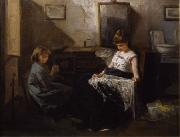 |
Domenico Induno
|
|
(1815 - 1878) was an Italian painter, originally a goldsmith.
He was born and died in Milan, and studied in the Academy of Fine Arts in Milan, as well as under Luigi Sabatelli and at Rome. He tried successively the Neoclassicism and Romantic schools, but afterwards settled down to depict popular life at Milan. In 1848 he took part with the Revolution, and had in consequence to flee to Switzerland. Thence he passed to Tuscany, and did not return home until 1859. His brother Gerolamo Induno was also a painter. Domenico married the sister of the Swiss painter Angelo Trezzini. Domenico often painted patriotic canvases, in a style indebted both to Ingres and Francesco Hayez. Among his paintings are:
|
|
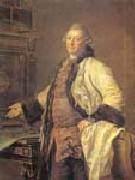 |
Dmitry Levitzky
|
|
1735-1822) was a Russian-Ukrainian portrait painter.
Dmitry was born in Kiev, Ukraine, in a family of clergyman and engraver Grigory Levitzky. His father was his first art teacher. Later be became a pupil of Aleksey Antropov who came to Kiev to paint the Cathedral of St. Andrew.
In 1770, Levitzky became famous as a portrait painter after the exhibition of six of his portraits in the Imperial Academy of Arts in St. Petersburg. For the portrait of Alexander Kokorinov, Director and First Rector of the Academy of Arts in St. Petersburg (1769) he was elected an academician and appointed the Professor of the portrait painting class at the Academy of Arts.
|
|
|
|
|
|
dioscoro teofilo de la puebla tolin
|
|
dioscoro teofilo de la puebla tolin(1831 to1901),who studied in madrid and rome,worked in the tradition fo historicism,asubgenre of history painting,which focused on the interplay of religious pride,patriotism ,and sntions of glory.tolin s technical style is referred to as eclecticism for its wide ranging,and often superficial ,borrowing from euopean techniques and visual trends. paintings in this genre were often funded by official organizations and art academies,which treated them as opportuities for propagandistic interpretations of history.the first landing of christopher columbus in america provides on shortage of drama
|
|
|
|
|
|
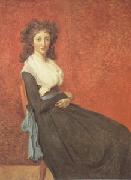 |
David, Jacques-Louis
|
|
French Neoclassical Painter, 1748-1825
Jacques-Louis David is famous for his huge, dramatic canvasses of Napoleon and other historical figures, including Oath of the Horatii (1784), Death of Marat (1793) and The Sabine Women (1799). Early in his career he was a leader in the neoclassical movement; later his subjects became more modern and political. David was himself active in the French Revolution as a supporter of Robespierre and is sometimes called the chief propagandist for the Revolution; after the Reign of Terror ended he was briefly imprisoned for his actions. When Napoleon took power David became his court painter and created several grand canvasses of the Emperor, including the heroic Napoleon Bonaparte Crossing the Alps (1801) and the enormous Coronation of Napoleon and Josephine (1807). David also painted Napoleon in His Study (1812),
|
|
|
|
 |
DALMAU, Lluis
|
|
Spanish Early Renaissance Painter, active 1428-1461
|
|
|
|
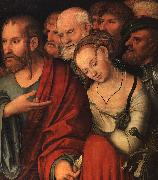 |
CRANACH, Lucas the Younger
|
|
German painter (b. 1515, Wittenberg, d.1586, Weimar)
was a German Renaissance artist, known for his woodcuts and paintings. He was a son of Lucas Cranach the Elder who began his career as an apprentice in his father's workshop. Henceforth, his own reputation and fame grew. After his father's death, he assumed control over the workshop. The style of their paintings can be so similar that there have been some difficulties in attribution of their works.
|
|
 |
CRANACH, Lucas the Elder
|
|
German painter (b. 1472, Kronach, d. 1553, Weimar).
German painter and engraver. The son of a painter, he settled in Wittenberg c.1504 and was court painter successively under three electors of Saxony. There he maintained a flourishing workshop and was twice burgomaster. Cranach was a close friend of Martin Luther, whose doctrine he upheld in numerous paintings and woodcuts, and he has been called the painter of the Reformation. He was a rapid and prolific painter, and the work turned out by his studio is uneven in quality. Naïve and fanciful, often awkward in draftsmanship, it has, nonetheless, freshness and originality and a warm, rich palette. His portraits are particularly successful. Among his best-known works are Repose in Egypt (Gemäldgalerie, Staatliche Mus., Berlin-Dahlem); Judgment of Paris (Staatliche Kunsthalle, Karlsruhe); Adam and Eve (Courtauld Inst., London); and Crucifixion (Weimar). The latter contains figures of Luther and Cranach. His many famous protraits include those of Elector John Frederick and Self-Portrait (Uffizi). Cranach was also an accomplished miniaturist. He produced a few copperplates and designs for woodcuts. His son and pupil Lucas Cranach, the Younger, 1515C86,
|
|
|
|
 |
COSTA, Lorenzo
|
|
Italian High Renaissance Painter, ca.1460-1535
was an Italian painter of the Renaissance. He was born at Ferrara, but moved to Bologna by the his early twenties, and would be more influential to the Bolognese school of painting. However, many artists worked in both nearby cities, and thus others consider him a product of the School of Ferrara. There are claims that he trained with Cosimo Tura. In 1483 he painted his famous Madonna and Child with the Bentivoglio family, and other frescoes, on the walls of the Bentivoglio chapel in San Giacomo Maggiore, and he followed this with many other works. He was a great friend of Francesco Francia, who was much influenced by him. In 1509 he went to Mantua, where his patron was the Marquis Francesco Gonzaga, and he eventually died there. His Madonna and Child enthroned is in the National Gallery, London, but his chief works are at Bologna. His sons, Ippolito and Girolamo, were also painters, and so was Girolamo's son, Lorenzo the younger (1537-1583).
|
|
|
|
 |
Cornelis Van Leemputten
|
|
(1841-1902) was a Belgian painter.
Born in Werchter, Cornelius van Leemputten is predominantly known for his landscapes with sheep, similar to the style of Charles Jacque. He began his painting career without formal training. He was well-known for his barnyard subjects. Leemputten eventually became a pupil of the Academy of Antwerp, though his style remained primarily self-taught.
Van Leemputten participated across several international exhibitions and received gold medals in Ghent in 1883, Edinburgh in 1886, Port Adelaide in 1887 and in Berlin in 1896. In 1895, he received the Knight of the Order of Leopold (Belgium).
|
|
|
|
|
|
 |
claude lorraine
|
|
Claude Lorrain (also Claude Gell??e or Le Lorrain) (Lorraine, c. 1600 ?C Rome, 21 or 23 November 1682) was an artist of the neo-classical era who was active in Italy, and is admired for his achievements in landscape painting.
|
|
 |
Claude Lorrain
|
|
French
1600-1682
Claude Lorrain Galleries
In Rome, not until the mid-17th century were landscapes deemed fit for serious painting. Northern Europeans, such as the Germans Elsheimer and Brill, had made such views pre-eminent in some of their paintings (as well as Da Vinci in his private drawings or Baldassarre Peruzzi in his decorative frescoes of vedute); but not until Annibale Carracci and his pupil Domenichino do we see landscape become the focus of a canvas by a major Italian artist. Even with the latter two, as with Lorrain, the stated themes of the paintings were mythic or religious. Landscape as a subject was distinctly unclassical and secular. The former quality was not consonant with Renaissance art, which boasted its rivalry with the work of the ancients. The second quality had less public patronage in Counter-Reformation Rome, which prized subjects worthy of "high painting," typically religious or mythic scenes. Pure landscape, like pure still-life or genre painting, reflected an aesthetic viewpoint regarded as lacking in moral seriousness. Rome, the theological and philosophical center of 17th century Italian art, was not quite ready for such a break with tradition.
In this matter of the importance of landscape, Lorrain was prescient. Living in a pre-Romantic era, he did not depict those uninhabited panoramas that were to be esteemed in later centuries, such as with Salvatore Rosa. He painted a pastoral world of fields and valleys not distant from castles and towns. If the ocean horizon is represented, it is from the setting of a busy port. Perhaps to feed the public need for paintings with noble themes, his pictures include demigods, heroes and saints, even though his abundant drawings and sketchbooks prove that he was more interested in scenography.
Lorrain was described as kind to his pupils and hard-working; keenly observant, but an unlettered man until his death. The painter Joachim von Sandrart is an authority for Claude's life (Academia Artis Pictoriae, 1683); Baldinucci, who obtained information from some of Claude's immediate survivors, relates various incidents to a different effect (Notizie dei professoni del disegno).
John Constable described Claude Lorrain as "the most perfect landscape painter the world ever saw", and declared that in Claude??s landscape "all is lovely ?C all amiable ?C all is amenity and repose; the calm sunshine of the heart"
|
|
|
|
|
|
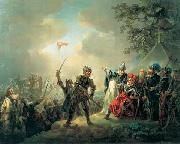 |
Christian August Lorentzen
|
|
(10 August 1749 - 8 May 1828) was a Danish painter. He was the instructor of Martinus Rørbye.
Christian August Lorentzen was born on 10 August 1749 as the son of a watchmaker. He arrived in Copenhagen around 1771 where he frequented the Royal Academy of Fine Arts but it is unclear whether he received formal training.From 1779 to 1782 he want abroad to develop his skills, visiting the Netherlands, Antwerp and Paris where he copied old masters. In 1792 he traveled to Norway to paint prospects.
In a number of painting, such as Slaget på Reden (1801, Danish Museum of National History and Den rædsomste nat (1807, Danish National Gallery, he documented key events from the English Wars between 1801 and 1814. Later in his career he mainly painted portraits, landscapes and scenes from Ludvig Holberg's comedies.
As a professor at the Royal Academy in Copenhagen from 1803 and until his death in 1828, he exercisized great influence on the next generation of painters such as Martinus Rørbye among others.
|
|
|
|
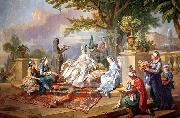 |
Charles-Amedee-Philippe van Loo
|
|
(25 August 1719 -15 November 1795) was a French painter of allegorical scenes and portraits.
He studied under his father, the painter Jean-Baptiste van Loo, at Turin and Rome, where in 1738 he won the Prix de Rome, then at Aix-en-Provence, before returning to Paris in 1745. He was invited to join the Academie Royale de Peinture et de Sculpture in 1747, and that year he married his cousin Marie-Marguerite Lebrun, daughter of the painter Michel Lebrun (died 1753).
Among his brothers were the painters François van Loo (1708-1732) and Louis-Michel van Loo (1707-1771).
|
|
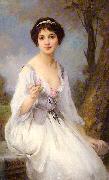 |
Charles-Amable Lenoir
|
|
(22 October 1860 - 1926) was a French painter. Like his mentor, William-Adolphe Bouguereau, he was an academic painter and painted realistic portraits as well as mythological and religious scenes. His artistic career was so prestigious that he won the Prix de Rome twice and was awarded the Legion d'honneur.
Lenoir was born in Châtellaillon, a small town just outside of La Rochelle. His mother was a seamstress and his father was a customs officer. When he was young, his father was reassigned and the family moved to Fouras. He did not start out in life as an artist, but instead began his education at a teachers' college in La Rochelle. Upon graduation, he worked as a teacher and supervisor at the lycee in Rochefort.
In August 1883 he was accepted into the École des Beaux-Arts de Paris, he also joined the Academie Julian where he was a student of William-Adolphe Bouguereau and Tony Robert-Fleury. Lenoir made his artistic debut at the Salon in 1887 and continued to exhibit there until his death. He was quickly noticed in the art world, and in 1889 won the Second Prix de Rome for his painting, Jesus et le paralytique (Jesus and a Sick Man with Palsy), and he won the First Prix de Rome the following year for Le Reniement de Saint Pierre (The Denial of St. Peter).His awards did not stop with the Prix de Rome; works shown at the Salons also won prizes, and he received a third-class medal in 1892 for Le Grenier a Vingt Ans (The Garret at twenty years) and a second-class medal in 1896 for La Mort de Sappho (The Death of Sappho).
|
|
 |
Charles Robert Leslie
|
|
1794 - 1859
was born in London on 19 October 1794. His parents were American, and when he was five years of age he returned with them to their native country. They settled in Philadelphia, where their son was educated and afterwards apprenticed to a bookseller. He was, however, mainly interested in painting and the drama, and when George Frederick Cooke visited the city he executed a portrait of the actor from recollection of him on the stage, which was considered a work of such promise that a fund was raised to enable the young artist to study in Europe. He left for London in 1811, bearing introductions which procured for him the friendship of West, Beechey, Allston, Coleridge and Washington Irving, and was admitted as a student of the Royal Academy, where he carried off two silver medals. At first, influenced by West and Fuseli, he essayed high art, and his earliest important subject depicted Saul and the Witch of Endor; but he soon discovered his true aptitude and became a painter of cabinet-pictures, dealing, not like those of David Wilkie, with the contemporary life that surrounded him, but with scenes from the great masters of fiction, from Shakespeare and Cervantes, Addison and Moli??re, Swift, Sterne, Fielding and Smollett. Of individual paintings we may specify Sir Roger de Coverley going to Church (1819); May-day in the Time of Queen Elizabeth (1821); Sancho Panza and the Duchess (1824); Uncle Toby and the Widow Wadman (1831); La Malade Imaginaire, act iii. sc. 6 (1843); and the Dukes Chaplain Enraged leaving the Table, from Don Quixote (1849). Many of his more important subjects exist in varying replicas. He possessed a sympathetic imagination, which enabled him to enter freely into the spirit of the author whom he illustrated, a delicate perception for female beauty, an unfailing eye for character and its outward manifestation in face and figure, and a genial and sunny sense of humour, guided by an instinctive refinement which prevented it from overstepping the bounds of good taste. In 1821 Leslie was elected A.R.A., and five years later full academician. In 1833 he left for America to become teacher of drawing in the military academy at West Point, but the post proved an irksome one, and in some six months he returned to England.
|
|
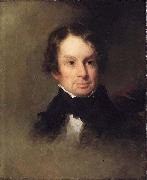 |
Charles Loring Elliott
|
|
1812-1868.
Elliott was born at Auburn, New York in the central part of the state. He began working as a painter in his region. After 10 years, he moved to New York City to study art under the painters John Trumbull and John Quidor, as well as to be in a bigger market for work.
After practicing portrait painting in central New York State for 10 years, Elliott took up residence in New York City in 1845. The following year he was elected to the National Academy of Design, which was a measure of recognition and helped him attract more clients.
Painting by Elliott of Samuel Putnam Avery, 1863Elliott was considered the best portraitist of his day. Although he never studied abroad, his technique is neither provincial nor uncertain. His method is mature, his drawing firm, his color fresh and clean, and his likenesses excellent, though somewhat lacking in sentiment.[citation needed] He was said to have painted over 700 portraits, mostly heads, as he had little idea of the composition of large canvases. He also painted figure pieces, including Don Quijote and Falstaff, and one landscape, The Head of Skaneateles Lake.
|
|
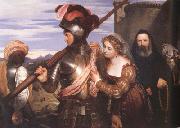 |
Charles Lock Eastlake
|
|
English Painter, 1793-1865
English painter, museum director, collector and writer. Fourth son of an Admiralty lawyer at Plymouth, he was educated at local grammar schools and then, briefly, at Charterhouse, Surrey. Determined to become a painter, he began work in 1809 as Benjamin Robert Haydon's first pupil and as a student at the Royal Academy Schools in London. In 1815 he exhibited for the first time at the British Institution, visited Paris and studied the pictures in the Musee Napoleon. He achieved his first conspicuous success with a scene from contemporary history that he had himself witnessed,
|
|
|
|
|
|
|
|
|
|
 |
Charles Leickert
|
|
22 September 1816, Brussels - 5 December 1907, Mainz was a Belgian painter of Dutch landscapes.
Orphan Leickert first learned painting in The Hague under the supervision of landscape painters Bartholomeus van Hove, Wijnand Nuijen, and Andreas Schelfhout among many others. Leickert specialised in winter scenes, sometimes romanticising the sky in pale blues and bright pinks. He painted almost all his works in the Netherlands, from 1841-1848 in The Hague and from 1849-1883 in Amsterdam. In 1856, he became a member of the Royal Academy of Amsterdam. At the age of 71 he moved to Mainz, Germany where he later died in 1907.
|
|
 |
Charles Lebrun
|
|
French Pand art Theorist ,
Paris1619-190
Virtual dictator of the arts in France until the death of Colbert in 1683. He established his reputation by a series of decorative schemes, and his own greatest compositions, which immortalize the achievements of the crown, are at Versailles. He became a founder, rector, chancellor, and finally director of the Academie Royale de Peinture et de Sculpture. He was also director of the Gobelins factory and Premier Peintre (1664). His Tent of Darius (1661), for Louis XIV, is a model of legibility, with the explicit and varied gesture and expression of the figures deriving from ideas expressed by Poussin. Lebrun's influential treatise,
|
|
 |
Charles le Brun
|
|
French Baroque Era Painter, 1619-1690
French painter and designer. He dominated 17th-century French painting as no other artist; it was not until over a century later, during the predominance of Jacques-Louis David, that artistic authority was again so concentrated in one man. Under the protection of a succession of important political figures, including Chancellor Pierre S?guier, Cardinal Richelieu and Nicolas Fouquet, Le Brun created a series of masterpieces of history and religious painting. For Louis XIV and his chief minister Jean-Baptiste Colbert he executed his greatest work, the royal palace of Versailles: an almost perfect ensemble of architecture, decoration and landscape. After Colbert's death in 1683, he was no longer able to count on prestigious commissions
|
|
 |
Charles Laval
|
|
(1862-1894) was a French painter born March 17, 1862 in Paris and who died April 27, 1894. He is associated with the Synthetic movement and Pont-Aven School, and he was a contemporary and friend of Paul Gauguin and Vincent van Gogh. Gauguin created a portrait of him in 1886 looking at one of Gauguin's Ceramic sculptures, entitled "Still Life with Profile of Laval".
Paul Gauguin and Laval both came to Pension Gloanec in Pont-Aven in 1886 and became friends. In search of an exoticism that could provide the key to art, Gauguin and Laval went to Panama in 1887. To gain some subsidies, Laval performs academic portraits (all lost), using his experience received from Leon Bonnat. A series of mishaps caused Laval and Gauguin to leave the Central America for the island of Martinique.
|
|
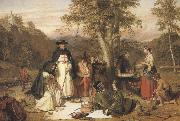 |
Charles landseer,R.A.
|
|
1799-1879
Painter, brother of Thomas Landseer. He trained initially with his father John Landseer, then under Benjamin Robert Haydon, and in 1816 he attended the Royal Academy Schools in London. In 1823 he accompanied Sir Charles Stuart de Rothesay (1779-1845) aboard HMS Wellesley on a voyage to Portugal and then to Brazil, in order to negotiate a commercial treaty with Pedro I, Emperor of Brazil (reg 1822-31). Many of the drawings he made on this trip were exhibited in 1828 at the British Institution, and in that year he sent his first painting to the Royal Academy. This was Dorothea, illustrating a scene from Cervantes's Don Quixote. He continued to exhibit at the Academy until his death, showing mostly romanticized history paintings or such literary subjects as Clarissa Harlowe in the Sponging House from Samuel Richardson's novel Clarissa (London, 1748). The English Civil War (1642-51) was of particular interest to him, his devotion to such historical subjects perhaps being attributable to the influence of his years with Haydon. He also painted portraits, genre scenes and animal studies . In 1837 he was elected ARA and in 1845 RA. In 1851, probably due to the influence of his brother Edwin, he succeeded George Jones as Keeper of the Royal Academy Schools. Responsible for instructing the antique class, his tenure was criticized both for the way his position had been obtained and for the deficiency of his teaching, and he retired from the Keepership in 1873 on full salary.
|
|
|
|
 |
Charles Landelle
|
|
1812-1908
French painter. His father, a calligrapher and musician from Mayenne, moved to Paris in 1825 to take up a post as musician in the Tuileries. Ary Scheffer, whom Landelle met through his father's contact with the Orleans court, encouraged him to become a painter. He registered at the Ecole des Beaux-Arts on 2 October 1837 as a pupil of Paul Delaroche and made his debut at the Salon in 1841 with a Self-portrait (Laval, Mus. Vieux-Cheteau). His first success, Fra Angelico asking God for Inspiration , indicated a sentimental, religious tendency in his work, which alternated with pretty pictures of young girls. Charity. commissioned by Antoine Vivenel (1799-1862), was followed by Idyll and Elegy (untraced), which were bought by the dealer Adolphe Goupil on the opening day of the 1844 Salon. The contract to buy also included Goupil's right of first refusal on the reproduction of all Landelle's future work. Subsequently, he painted the Three Marys at the Tomb in the pious manner of Ary Scheffer and a sweet, angelic St Cecilia, commissioned in 1845 by the Prefect of the Seine, in which elements of the early Renaissance art seen by Landelle on a trip to Italy in 1845 combined with the soft, pale style common among some of his colleagues from the studio of Delaroche. He also painted religious works for St Roch (1850), St Germain l'Auxerrois (1856) and St Sulpice (1875) churches in Paris.
|
|
 |
Charles de Lafosse
|
|
French Baroque Era Painter ,
Paris 1636/40 -1716
French painter and draughtsman. He was the most important decorative painter in France in the generation after Charles Le Brun and in this capacity contributed to many of the major official and private building projects from the 1670s to the 1710s, including the D?me des Invalides in Paris and the chapel at the ch?teau of Versailles. His colourist's temperament, his early study of the Venetian painters of the 16th century and his interest in the work of Peter Paul Rubens contributed to the triumph of the party that championed colour over line and put him in the vanguard of the new tendency in French painting in the later 17th century. His work, with its rich and changing colours, combines the strength of the 17th century with the lightness and grace of the 18th
|
|
 |
Charles de La Fosse
|
|
(June 16, 1636 - December 13, 1716), French painter, was born in Paris.
He was one of the most noted and least servile pupils of Le Brun, under whose direction he shared in the chief of the great decorative works undertaken in the reign of Louis XIV. Leaving France in 1662, he spent two years in Rome and three in Venice. The influence of his prolonged studies of Veronese is evident in his "Finding of Moses" (Louvre), an in his "Rape of Proserpine" (Louvre), which he presented to the Royal Academy as his diploma picture in 1673. He was at once named assistant professor, and in 1674 the full responsibilities of the office devolved on him, but his engagements did not prevent his accepting in 1689 the invitation of Lord Montagu to decorate Montagu House.
He visited London twice, remaining on the second occasionetogether with Rousseau and Monnoyer more than two years. William III vainly strove to detain him in England by the proposal that he should decorate Hampton Court, for Le Brun was dead, and Mansart pressed La Fosse to return to Paris to take in hand the cupola of Les Invalides. The decorations of Montagu House are destroyed, those of Versailles are restored, and the dome of the Invalides (engraved, Picart and Cochin) is now the only work existing which gives a full measure of his talent. During his latter years La Fosse executed many other important decorations in public buildings and private houses, notably in that of Crozat, under whose roof he died on 13 December 1716.
This article incorporates text from a publication now in the public domain: Chisholm, Hugh, ed (1911). Encyclopædia Britannica (11th ed.). Cambridge University Press.
|
|
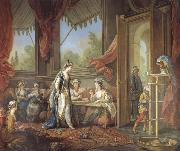 |
Charles Amedee Philippe Van Loo
|
|
French Painter, 1719-1795, was a French painter of allegorical scenes and portraits. He studied under his father, the painter Jean-Baptiste van Loo, at Turin and Rome, where in 1738 he won the Prix de Rome, then at Aix-en-Provence, before returning to Paris in 1745. He was invited to join the Academie Royale de Peinture et de Sculpture in 1747, and that year he married his cousin Marie-Marguerite Lebrun, daughter of the painter Michel Lebrun (died 1753). Among his brothers were the painters Francois van Loo (1708-1732) and Louis-Michel van Loo (1707-1771).
|
|
|
|
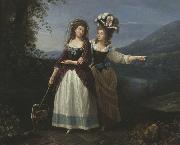 |
Carlo Labruzzi
|
|
painted Aleksandra and Izabela Potocki taking a stroll near to lake Albano in 1779-1780
|
|
 |
Carlo Innocenzo Carlone
|
|
(1686-1775) was an Italian painter and engraver, active especially in Germany.
He was a native of Scaria, near Como, in Lombardy, but may have been from the Carloni family of Genoese painters. He was the son of a sculptor, but he preferred painting, and was placed under the care of Giulio Quaglio. He afterwards studied at Venice and at Rome, until he was 23 years of age, when he visited Germany, where he has left works in oil and in fresco at Ludwigsburg, Passau, Linz, Breslau, Prague, and Vienna.
He painted large decorative fresco cycles for palaces in Vienna, Prague and Southern Germany. For example, Carlone is known for painting the ceiling images in the Upper Belvedere of the Belvedere palace complex. His The Glorification of Saints Felix and Adauctus (1759-61) was commissioned for the cupola of the church of San Felice del Benaco on Lake Garda. He died at Como.
|
|
|
|
|
|
|
|
|
| Wholesale China Oil Painting Wholesale Oil Painting China Xiamen Portrait Reproduction on canvas Chinese Oil Painting Wholesale USA Oil Painting |
|
|
|
|
|